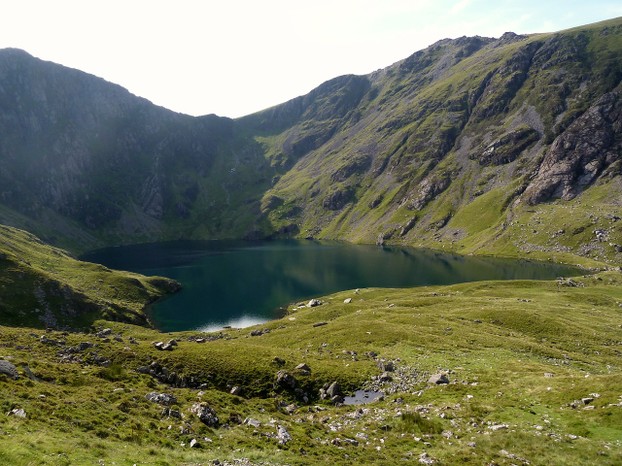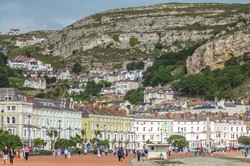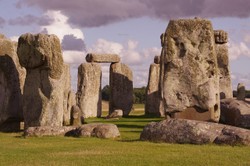I have seen Roman roads, in fact I live a few hundred yards from a modern road that runs along the course of a Roman one, now covered by the modern surface. But Sarn Helen varies in the degree of preservation. At some places its route is obscured, only to be revealed to the discerning eye by the occasional presence of the remnants of Roman marching camps, overnight structures for temporary shelter for men who were not popular with the native Britons, but at other places they are discernible as a well-preserved stone surface.
Sarn Helen is a trace in the landscape that begins in the industrial south of Wales, in the area called Neath, bordering the Bristol Channel, which separates Wales from Cornwall. Bullough, the author, does a good job in managing the description of the post industrial landscape of that part of Wales with an account of the historical factors which have shaped it and which in many cases remain as brooding relics of the past. The first part the journey took the author through the Welsh Valleys, southward draining watercourses that empty into the Bristol Channel. These are the areas most scarred by Wales' coal mining heritage. The author wants to pass through this now redundant relic of history that is integral to the story of Wales .yet he is no one-sided detractor, for he is alert to efforts to improve the area, and recounts the friendly encounters that he shared with his fellow Welsh folk.
The name for the road is not Roman, but native Welsh. It derives from the hero Maxim Wledig, who was a popular figure in his three year spell as Roman emperor in the West. He ruled Roman Britain, Gall and Spain, but was killed by rival Roman forces. He is associated with a queen called Helen, who may have been his mother, but the myth of Maxim, which may be short for Maximus, has little historical credibility short of mentioning his existence.
The writer skillfully weaves his way from South to North Wales interacting with the historic landscape, and drawing on historical and mythological sources. He also includes accounts of encounters with other people whom he meets in passing. These people are not seen as intrusive into the account of the landscape, but are integral to the living history of the land through which he is walking. The route he takes is always south to north with the Cambrian Mountains always to the east of him. This range is the backbone of Wales and is divided into smaller ranges. During his walk he does not attempt to ascend the Cambrians, but regards them as a backdrop to his journey.








 TheThousand Year Gardenon 11/26/2025
TheThousand Year Gardenon 11/26/2025
 Women of the Gospelson 10/11/2025
Women of the Gospelson 10/11/2025
 Religious Gardenson 08/25/2025
Religious Gardenson 08/25/2025
 Doctor of the Church: John Henry Newmanon 08/03/2025
Doctor of the Church: John Henry Newmanon 08/03/2025


Comments
Thanks for this lovel guide. Wales is already on my bucket list for years:)
All sentient species.
Thank you for your comment below, in answer to my previous observation and question.
The last subheading, Other parts of the book, references Extinction rebellion.
Would that group be working for animal-sentient species, people species, plant-sentient species or all?
All technological items are limited by their design, which is linked to their designed purpose.
Thank you for your comment below, in answer to my previous observation and question.
Your answer defers to cell-phone messages and pictures. Does that mean that cell phones and laptop computers work in limited ways or like they do in everyday, ordinary, peopled environments (such as your computer corner ;-D)?
The authornofna walking book of this kind can use a variety of recording methods. Cell phones can take pictures, and messages may be sent, but extended text is the product of reflection, which takes Some tIme after the walk has finished. Though photographs record scenes, they are not a substitute for sketching, as art allows for interpretation of the author's emotional involvement with the journey
Pre-electronic times compelled sketching or writing materials for in-the-moment, on-site remembrances.
Electronic times do not eliminate doing likewise audio-, digital-, virtual-, visual-ly even as they perhaps eliminate no above-mentioned traditional equivalents.
Your answer three comment boxes down figures this walk as favoring about two weeks.
Might technology such as cell phones and laptops operate along these trails or might traditional means, such as journals and sketchbooks, prevail?
It depends on the walkers and their needs and preferences. So there is no set of statistics which I could use to answer your question. Sorry.
Unitedstatesian walked routes -- such as the Appalachian Trail -- can be solitary, groupy, couple-y, with the latter perhaps the popularest.
Does there seem to be an eastern-pond trend toward walking routes such as this in solitary, group or coupled formation?
He, did not do the walk in one go, so I cannot say, but I think that avwalker should allow two weeks, which is a reasonable time for a country the size of wales.